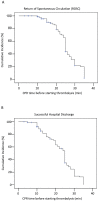Impact of rescue-thrombolysis during cardiopulmonary resuscitation in patients with pulmonary embolism
- PMID: 20016808
- PMCID: PMC2788709
- DOI: 10.1371/journal.pone.0008323
Impact of rescue-thrombolysis during cardiopulmonary resuscitation in patients with pulmonary embolism
Abstract
Background: Cardiac arrest in patients with pulmonary embolism (PE) is associated with high morbidity and mortality. Thrombolysis is expected to improve the outcome in these patients. However studies evaluating rescue-thrombolysis in patients with PE are missing, mainly due to the difficulties of clinical diagnosis of PE. We aimed to determine the success influencing factors of thrombolysis during resuscitation in patients with PE.
Methodology/principal findings: We analyzed retrospectively the outcome of 104 consecutive patients with confirmed (n = 63) or highly suspected (n = 41) PE and monitored cardiac arrest. In all patients rtPA was administrated for thrombolysis during cardiopulmonary resuscitation. In 40 of the 104 patients (38.5%) a return of spontaneous circulation (ROSC) could be achieved successfully. Patients with ROSC received thrombolysis significantly earlier after CPR onset compared to patients without ROSC (13.6+/-1.2 min versus 24.6+/-0.8 min; p<0.001). 19 patients (47.5%) out of the 40 patients with initially successful resuscitation survived to hospital discharge. In patients with hospital discharge thrombolysis therapy was begun with a significantly shorter delay after cardiac arrest compared to all other patients (11.0+/-1.3 vs. 22.5+/-0.9 min; p<0.001).
Conclusion: Rescue-thrombolysis should be considered and started in patients with PE and cardiac arrest, as soon as possible after cardiac arrest onset.
Conflict of interest statement
Figures


Similar articles
-
Successful thrombolytic therapy of post-operative massive pulmonary embolism after ultralong cardiopulmonary resuscitation: a case report and review of literature.Clin Respir J. 2017 May;11(3):383-390. doi: 10.1111/crj.12332. Epub 2015 Jul 24. Clin Respir J. 2017. PMID: 26083151 Review.
-
Thrombolysis During Resuscitation for Out-of-Hospital Cardiac Arrest Caused by Pulmonary Embolism Increases 30-Day Survival: Findings From the French National Cardiac Arrest Registry.Chest. 2019 Dec;156(6):1167-1175. doi: 10.1016/j.chest.2019.07.015. Epub 2019 Aug 2. Chest. 2019. PMID: 31381884
-
Evaluation of Rescue Thrombolysis in Cardiac Arrest Secondary to Suspected or Confirmed Pulmonary Embolism.Ann Pharmacother. 2019 Jul;53(7):711-715. doi: 10.1177/1060028019828423. Epub 2019 Jan 30. Ann Pharmacother. 2019. PMID: 30700101
-
Thrombolysis after initially unsuccessful cardiopulmonary resuscitation in presumed pulmonary embolism.Am J Emerg Med. 2015 Jan;33(1):132.e1-2. doi: 10.1016/j.ajem.2014.06.031. Epub 2014 Jul 1. Am J Emerg Med. 2015. PMID: 25074694
-
Can Systemic Thrombolysis Improve Prognosis of Cardiac Arrest Patients During Cardiopulmonary Resuscitation? A Systematic Review and Meta-Analysis.J Emerg Med. 2019 Oct;57(4):478-487. doi: 10.1016/j.jemermed.2019.07.011. Epub 2019 Oct 5. J Emerg Med. 2019. PMID: 31594741
Cited by
-
Emergency Thrombolysis During Cardiac Arrest Due to Pulmonary Thromboembolism: Our Experience Over 6 Years.Open Access Emerg Med. 2021 Feb 22;13:67-73. doi: 10.2147/OAEM.S275767. eCollection 2021. Open Access Emerg Med. 2021. PMID: 33654439 Free PMC article.
-
Fatal pulmonary embolism update: 10 years of autopsy experience at an academic medical center.JRSM Short Rep. 2013 Jul 30;4(9):2042533313489824. doi: 10.1177/2042533313489824. eCollection 2013. JRSM Short Rep. 2013. PMID: 24040503 Free PMC article.
-
International Survey of Thrombolytic Use for Treatment of Cardiac Arrest Due to Massive Pulmonary Embolism.Crit Care Explor. 2020 Jun 9;2(6):e0132. doi: 10.1097/CCE.0000000000000132. eCollection 2020 Jun. Crit Care Explor. 2020. PMID: 32695997 Free PMC article.
-
Management of high-risk pulmonary embolism in the emergency department: A narrative review.Am J Emerg Med. 2024 May;79:1-11. doi: 10.1016/j.ajem.2024.01.039. Epub 2024 Feb 3. Am J Emerg Med. 2024. PMID: 38330877 Free PMC article. Review.
-
[The patient with pulmonary embolism or vascular emergency requiring intensive care].Internist (Berl). 2010 Aug;51(8):995-8, 1000-2. doi: 10.1007/s00108-009-2541-5. Internist (Berl). 2010. PMID: 20596688 Review. German.
References
-
- Hoffmann B, Gross CR, Jockel KH, Kroger K. Trends in mortality of pulmonary embolism - an international comparison. Thromb Res 2009 - PubMed
-
- Kasper W, Konstantinides S, Geibel A, Olschewski M, Heinrich F, et al. Management strategies and determinants of outcome in acute major pulmonary embolism: results of a multicenter registry. J Am Coll Cardiol. 1997;30:1165–1171. - PubMed
-
- Goldhaber SZ, Visani L, De Rosa M. Acute pulmonary embolism: clinical outcomes in the International Cooperative Pulmonary Embolism Registry (ICOPER). Lancet. 1999;353:1386–1389. - PubMed
-
- Lualdi JC, Goldhaber SZ. Right ventricular dysfunction after acute pulmonary embolism: pathophysiologic factors, detection, and therapeutic implications. Am Heart J. 1995;130:1276–1282. - PubMed
-
- Jardin F, Dubourg O, Bourdarias JP. Echocardiographic pattern of acute cor pulmonale. Chest. 1997;111:209–217. - PubMed
Publication types
MeSH terms
Substances
LinkOut - more resources
Full Text Sources
Medical

